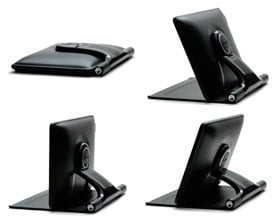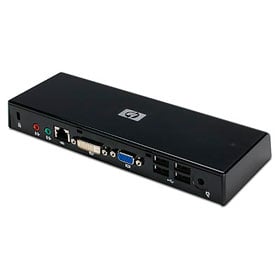DisplayLink Revisited
Back in April, I had to the chance to review a pair of 7-inch, USB-powered, LCDs, meant to be used as secondary displays. Both displays were Nanovision Mimo Monitors and used DisplayLink technology. They were similar in design and function, with the primary difference being that one of them included touch-screen support. Ultimately, I liked the non-touch-screen version, as it provided just enough screen real-estate to make an alternative home for my IM, Skype, and Twitter client apps, as well as the occasional photo or video editing app palette window--therefore freeing up some space on the screen of my primary display. The touch-screen version did this too, but I didn't really have a need for touch-screen capabilities on such a small display, and the non-touch-screen version has a brighter and crisper display.
Fast-forward to a few weeks ago, when the folks at DisplayLink sent me two new devices to check out. One is an updated 7-inch, touch-screen Mimo display, and the other is a USB docking station from HP. I'll start with my impressions of the new Mimo touch-screen display...
The new Mimo 720-S has the same technical specifications as the Mimo 740 we looked at in April:
- Display size: 7-inches
- Display resolution: 800 x 480
- Brightness: 350 cd/m2
- Contrast ratio: 400:1
 How the 720-S differs from the 740 is that the 720-S is a much sleeker and lighter model--meant for easy portability--and the 720-S also lacks the 1.2-megapixel webcam of the 740. When not in use or while in transit, the 720-S folds up to only about an inch thick at its thickest point, and it weighs less than a pound. A single mini-USB jack is located on the back of the unit, hiding underneath a rubber cap. The display's only controls are power and brightness. The display can be rotated for either landscape or portrait modes. I didn't like that the tilt wasn't adjustable--especially since I felt that the display tilted too far back when in portrait mode.
How the 720-S differs from the 740 is that the 720-S is a much sleeker and lighter model--meant for easy portability--and the 720-S also lacks the 1.2-megapixel webcam of the 740. When not in use or while in transit, the 720-S folds up to only about an inch thick at its thickest point, and it weighs less than a pound. A single mini-USB jack is located on the back of the unit, hiding underneath a rubber cap. The display's only controls are power and brightness. The display can be rotated for either landscape or portrait modes. I didn't like that the tilt wasn't adjustable--especially since I felt that the display tilted too far back when in portrait mode.
Unfortunately, I already sent the 740 back to DisplayLink, so I didn't have a chance to do a side-by-side comparison of image quality. As far as memory goes, however, the image quality is comparable--meaning that the display has decent image quality, but suffers from a somewhat muted and grainy appearance (presumably from the touch-screen elements of the display) and not so great color accuracy. Once again, I was pleasantly surprised by the display's performance when playing back video, as I didn't see any noticeable lag--not that I would actually use a 7-inch display for watching video. The install disc comes with 32-bit and 64-bit drivers for Windows XP and Vista; however, I was unable to get the touch-screen driver to work properly on my HP Pavilion Elite m9550f testbed running 64-bit Vista. Ultimately, I wound up using the same 64-bit driver that DisplayLink sent me last April for the review of the Mimo 740. Even though the driver from April had a newer version number, I wasn't able to install it on top of the driver I had already installed from the disc--I had to use Windows' System Restore to reset the OS back to before the driver was installed. I finally got the touch-screen driver working, but it was a painful and time-consuming process. (BTW: A beta driver is available for download from the DisplayLink site for Windows 7.)
The install disc comes with 32-bit and 64-bit drivers for Windows XP and Vista; however, I was unable to get the touch-screen driver to work properly on my HP Pavilion Elite m9550f testbed running 64-bit Vista. Ultimately, I wound up using the same 64-bit driver that DisplayLink sent me last April for the review of the Mimo 740. Even though the driver from April had a newer version number, I wasn't able to install it on top of the driver I had already installed from the disc--I had to use Windows' System Restore to reset the OS back to before the driver was installed. I finally got the touch-screen driver working, but it was a painful and time-consuming process. (BTW: A beta driver is available for download from the DisplayLink site for Windows 7.)
Mac drivers are not included on the disc, but can be downloaded from DisplayLink's website. As I recently upgraded my MacBook Pro to Snow Leopard, the only available driver that works on the new OS is a beta. The driver installed fine and I was up and running quickly on the Mac... Well, the display portion anyway... While the Mimo touch-screen monitors come with the touch-screen drivers for Windows, you actually need to purchase the Mac touch-screen drivers separately ($30). I still had the Mac touch-screen driver from April, but I was unable to get it to successfully install under Snow Leopard. (My iMac still has Leopard on it, but the system is currently at the shop getting fixed, so I didn't have a Leopard system available for testing.)
All-in-all, the 720-S did what it is supposed to--at least under Windows. Since I really don't utilize the touch-screen functionality of the display, however, I would probably be better off with the less expensive, non-touch-screen 710-S version. The 720-S sells for $229.99, while the 710-S (which I did not evaluate) costs $149.99 The other DisplayLink device I had a chance to play with was the HP USB 2.0 Video Dock. This is actually quite an ingenious device for those who want a simple docking station with external monitor support--where the only connection between your laptop and the docking station is a single USB 2.0 connection. The HP dock includes a four-port USB hub, VGA out, DVI out, 100Mbps Ethernet, mic-in, and headphone-out. Unlike the Mimo monitors, the HP dock is not USB bus-powered, so it requires an external power source.
The other DisplayLink device I had a chance to play with was the HP USB 2.0 Video Dock. This is actually quite an ingenious device for those who want a simple docking station with external monitor support--where the only connection between your laptop and the docking station is a single USB 2.0 connection. The HP dock includes a four-port USB hub, VGA out, DVI out, 100Mbps Ethernet, mic-in, and headphone-out. Unlike the Mimo monitors, the HP dock is not USB bus-powered, so it requires an external power source.
The HP dock's drivers are stored on the device itself, in built-in flash memory; they installed easily and I was up and running in no time. I connected an Ethernet cable to the device's network jack, powered speakers to the headphone jack, a few USB peripherals to the USB hub, and a monitor to the DVI port. Keep in mind, the only connection between my Windows testbed system and the HP dock was a single USB cable. Yet with only this single connection, the HP dock was simultaneously providing network access, sending audio to the speakers, connecting to the USB peripherals plugged into the USB hub, and sending video to a second display. Video response appeared very quick with no noticeable lag. Needless to say, I was very impressed with how seamless the HP dock worked.
Despite having two different video-out ports, only one can work at a time--you can't use the device to send video to two external displays simultaneously. The HP Dock supports resolutions up to UXGA (1600x1200) or WSXGA+ (1680x1050).
The HP Dock does not come with Mac drivers, but I decided to see what would happen if I connected my MacBook Pro to it. Surprisingly, the video out, audio out, and USB hub all worked! (The DisplayLink driver was already installed from my testing with the Mimo 720-S, and the USB audio and USB hub capabilities are already built into the Mac OS.) The only thing I couldn't get to work with the MacBook Pro was the HP Dock's Ethernet connection--but as nearly all laptops these days come with wireless NICs, that is not a showstopper (albeit, the 100Mbps Ethernet connection will be faster than an 802.11a/b/g/n connection). The big caveat here, however, is that the video response was noticeably slow with plenty of lag--of course, I was using the HP Dock for an unintended purpose, so it's not fair to ding it for this.
The HP USB 2.0 Docking Station measures 1.1x8.66x3.2-inches (HWD) and weighs 11.32-oz. HP was selling it for $129.99, but they've just added a $32.50 instant rebate, bringing the price down to $97.49.
DisplayLink devices currently have a number of limitations, such as lack of OpenGL support (i.e., Windows 3D screensavers don't display on DisplayLink monitors), known issues with some full-screen motion video playback, and they can't be used as a primary display (a small 7-inch display could be ideal for media sever). But, overall, I've been relatively impressed with the DisplayLink devices I've looked at. And with Wireless USB and USB 3.0, it will be interesting to see what sort of DisplayLink products we'll see in the near future. Stay tuned...

